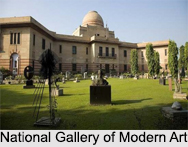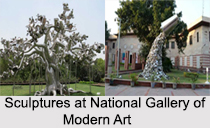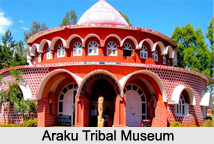 Located in the capital city of the country, New Delhi, the main museum of the National Gallery of Modern Art is actually situated at the Jaipur House, which once used to be the former residence of the Maharaja of Jaipur. The Jaipur House is located near the India Gate and on 29th March, 1954 the National Gallery of Modern Art was established as a centre of cultural cultivation with subsequent branches at cities like Mumbai and Bengaluru.
Located in the capital city of the country, New Delhi, the main museum of the National Gallery of Modern Art is actually situated at the Jaipur House, which once used to be the former residence of the Maharaja of Jaipur. The Jaipur House is located near the India Gate and on 29th March, 1954 the National Gallery of Modern Art was established as a centre of cultural cultivation with subsequent branches at cities like Mumbai and Bengaluru.
History of National Gallery of Modern Art
History recounts, that the Art Conference, that took place in Kolkata, erstwhile Calcutta, in 1949, first raised the vital issue of the necessity for setting up a museum to promote modern Art in India. The infamous butterfly shaped Jaipur House with its central dome was picked to house the National Gallery of Modern Art as it represented sophistication and aristocracy. The inauguration of the National Gallery of Modern Art was marked by an exhibition of sculptures and was formally inaugurated by Vice President, Dr. S. Radhakrishnan in the year 1954. This show spoke of the painstaking preparations made by the first curator of the National Gallery of Modern Art called Hermann Goetz, who was a noted German art historian. Under him, the National Gallery of Modern Art had a string of distinguished directors and in time it added new facilities such as Art restoration services, an Art reference Library and a Documentation Centre.
 The National Gallery of Modern Art, New Delhi, is under the respectable supervision of the Department of Culture, Government of India. Its premise of artistic-perfection can be accessed by anyone on any day of the week.
The National Gallery of Modern Art, New Delhi, is under the respectable supervision of the Department of Culture, Government of India. Its premise of artistic-perfection can be accessed by anyone on any day of the week.
Galleries of National Gallery of Modern Art
The National Gallery of Modern Art pays a tribute to the cultural heritage of India. It wonderfully exhibits the transitions marking the art and works of art, spanning over 150 years. This research conducted in the sphere of Visual and Plastic arts, has begun with the art-forms of 1857. The institution of the National Gallery of Modern Art is inspired with a lofty vision and mission. Its primary task is to collect and protect the invaluable artefacts of Modern Art, produced since the 1950s.
Next, the Museum Authorities has matched their performance with their promise of preserving and improvising the galleries for exhibition, in accordance to the needs of the hour. For the spread of an aesthetic awareness, the National Gallery of Modern Art has found the art-exhibitions as the right instrument. Exhibitions held not only in the Museum galleries, but also in other areas of the country, fulfil this purpose. The generation of artistic consciousness has been solidified with the growth of an educational and record-keeping department, called the Documentation Centre.
The urgency of a specific library of books, periodicals, photographs and other audio visual materials erected the Art Reference Library of the National Gallery of Modern Art .It consists of relevant books on painting, sculpture, graphics, architecture and other miniature form of arts, enlighten an ardent pursuer of art with the knowledge of history of art, art criticism, and art-analysis. The Library contributes to 32 substantial art magazines of Indian and International character. Card Indexes and photographs of art-kinds, belonging to the National Gallery of Modern Art, act as reference and study material, grouped in three categories. They are arranged, "Accession wise, Alphabetical listing of artists; and also Classification according to media".
Black and white photographs of all display objects, taken over, temporarily, by the National Gallery of Modern Art for the frequently occurring special exhibitions are available. These photographs facilitate research studies at the Documentation Centre. The Documentation Centre of the National Gallery of Modern Art is enriched with a Photo Studio of good infrastructure.
 The educational enterprise and maintenance of data, undertaken by the National Gallery of Modern Art, conserve data, associated with Modern Art. The prime principle of the Museum Authority is to dissipate artistic education among commoners and simultaneously to serve the purposes of elite professionals and art-intelligentsia. The Educational and Cultural Activities, includes, the interactions with school children, with simple issues of art ; illuminating campaigns for mass; directing artists with exhibitions, also of international patterns, and important documents; complementing the prowess of art-professionals with lectures, seminars, research-sessions and film-shows; and finally to impart practical instructions to both the children and the adults, through Art Sketch Club.
The educational enterprise and maintenance of data, undertaken by the National Gallery of Modern Art, conserve data, associated with Modern Art. The prime principle of the Museum Authority is to dissipate artistic education among commoners and simultaneously to serve the purposes of elite professionals and art-intelligentsia. The Educational and Cultural Activities, includes, the interactions with school children, with simple issues of art ; illuminating campaigns for mass; directing artists with exhibitions, also of international patterns, and important documents; complementing the prowess of art-professionals with lectures, seminars, research-sessions and film-shows; and finally to impart practical instructions to both the children and the adults, through Art Sketch Club.
The representatives of the National Gallery of Modern Art also go forward in explaining people the interdependent nexus between visual and performing arts with the airing of film shows and use of tape-recorded music.
Other Inclusions of National Gallery of Modern Art
The precious collection of the National Gallery of Modern Art consists of paintings, sculptures, graphics and photographs, snapped by both Indian and international artists. The historical advancement of Modern Art in India comes into the limelight of focus, through the projection of the art-productions of various schools and art-groups. For instance the paintings of Raja Ravi Varma and academic realists, the Bengal School and International modern art, each constituting a distinct school by themselves, each has a discrete charm.
The collection is a treasure-chest of the renowned paintings of artists, like, Thomas Daniel, Abanindranath Tagore, Rabindranath Tagore, Gaganendranath Tagore, Nandalal Bose, Jamini Roy and Amrita Sher-Gil. Besides, other famous contemporary artists of the country, has also teamed their achievements with the magnificent collection.
The international collection showcases splendid sculptures, graphics and paintings, done by international modern artists, namely, Jacob Epstein, Giorgio de Chirico, Sonia Delaunay, A. Tapies, Robert Rauschenberg, Se Duk Lee, D.C. Daja, Peter Lubarda, Kozo Mio, George Keyt and Fred Thieler.
The mind-blowing sculptures are installed in galleries, adjacent to the lawns, about to turn out into the makeover of a sculpture- garden. Meticulous attention is given to the observance of the aims and rules, finalized by the National Gallery of Modern Art, which is now the insignia of the rising zeal for Modern Art.













